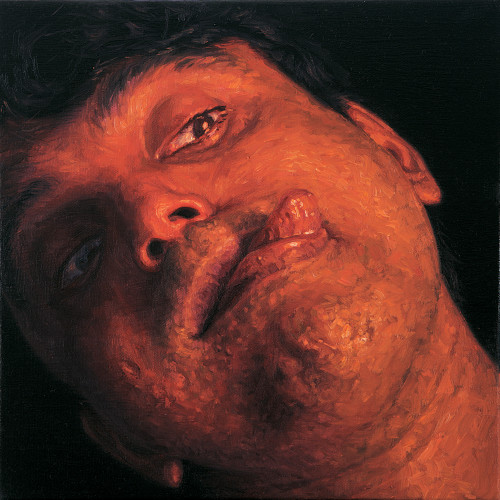
Abir Karmakar
“The idea of fine art which emerged in the eighteenth century, symbolized by Kant’s aesthetics—and there was no concept of aesthetics in traditional philosophy—and then by the discourses by Reynolds, that that’s on the way out, it’s going. I think art is becoming very ideological, and it’s less interested in mediating this special experience called the “aesthetic,” which you can get outside of art but which is intensified and more concentrated within the, so to say, closed circle of discourse which is art.”
Donald Kuspit
“The double nature of pleasure is something that I wanted to trace out. For pleasure to be what it is, it has to exceed a limit of what is altogether wholesome and healthy. Our idioms reflect this: when we like something we tend to say we were “blown away” or “It killed me,” and other deadly utterances. To the extent that pleasure is something that one seeks, it also has to make us confront the limits of our being. Otherwise it’s something like contentedness, which can be shown to be in fact an abandonment of pleasure. “
Avital Ronell
“There is always something whose absence can always be observed in a picture – which is not the case in perception.”
Jacques Lacan
Kuspit gave a fascinating lecture on the Spiritual in Art. This was back in 2003. And I was thinking of this lecture for some reason, maybe because I had run across some article on Kandinsky, who Kuspit focused on, and maybe also because I feel this is a topic that has been increasingly removed from public discourse (such as it is). I also found myself pouring through Christie’s archives of past auctions, and later Sotheby’s. It is a strange experience, as one might expect. There are obviously artists who fetch very little, who one would think would command more, and vice versa, of course. Anne Ryan, for example, sells for a few thousand dollars. And Ryan is at least a significant minor woman artist in the U.S. mid century. Or Hannelore Baron, whose work generates even less money than Ryan. And I might argue this as even more inexplicable (feel free, investors in fine art, to buy up some Baron and Ryan, this is your tip for the day). In some ways Baron is a bit like the fine arts version of Robert Walser. She made strange claustrophobic little shadow boxes and collages, and paper constructions and miniature books. But perhaps it makes sense in another way as Baron’s work was never made for mass display. Much of it can’t be hung on walls. It was to be viewed by single individuals, in private. Hers is the world of absolute privacy and intimacy; two things in scant supply today. She was a withdrawn woman, an emigre from Germany who fled the Nazis as a girl, with her family. And her work is spiritual, almost by default. And her haunted personal life finds expression in her almost macabre somber little assemblages.

Christian Boltanski
Now, Kuspit writes…
“One of the reasons that Kandinsky was concerned with inner life is that it registers the pernicious emotional effects of outer materialistic life, affording a kind of critical perspective on materialism that becomes the springboard for emotional transcendence of it. The inability of Pop art to convey inner life, which is a consequence of its materialistic disbelief in interiority, and especially spirituality, which is the deepest interiority, indicates that Pop art’s irony is at best nominally critical. Irony in fact mocks belief, even as it spices up materialism, making it seem less banal, that is, populist, thus giving Pop art the look of deviance characteristic of avant-garde art. I dwell on irony because it is opposed to spirituality, not to say incommensurate with it, and also its supposedly more knowing alternative—spiritual people are supposed to be naïve—and because irony has become the ruling desideratum of contemporary art, if you’re not ironical, you’re not in, apparently redeeming its materialism.”
If Baron was an example of art for the individual, for the solitary viewer, then Warhol, as Kuspit points out, is the art of the crowd. It is business art, for a business crowd. The corporate lobbies of Fortune 500 companies tend toward the display of the most spiritual artworks as both a means to capture some of the vibe, but also partly to neutralize it. And there is a psychoanalytical aspect to this, as Kuspit points out with the Warhol ‘gold Marlyn’, the feces/filthy lucre linkage is never far from view and this constipation of the collective Capitalist imagination finds expression both in adoration and in denial and aggression. Society itself is a collective borderline personality.
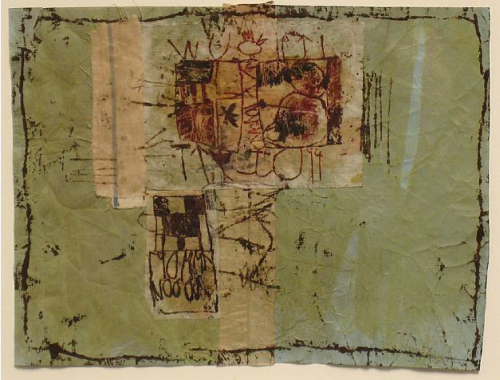
Hannelore Baron
I have said before that certain artists are silent, or their work is silent, or quiet at least. Marco Tirelli produces silent work. In theatre today, what Kandinsky wrote about forms that have reached their fulfillment is very true. And some of this is, as I said last post, a product of institutionalization. But it is more than that. It is the draining away of the spiritual. And if one doesn’t like that word, one can say aesthetic experience. The demand for the empirical, for a positivist reading of cultural products is, in the end, per Kuspit, emotionally reactionary. And it corrupts this quality of quietude. One can feel, in theatre, the silence approaching in Beckett and Kane and Pinter. And there is also a sort of ersatz silence one feels in a lot of artwork. And this is much harder to diagnose, in a sense. But more on that below. The issue of the spiritual is also connected with wider cultural shifts that began after WW2, but intensified greatly in the late 70s. The post Vietnam war period, where something occurred in the way mass culture and the internet and electronic communications were driving away time and space necessary for reflection. Kuspit also notes that the influence of Greenberg was both positive, and at times acutely negative. And the negative aspect was the way Greenberg saw artists as mastering their paint (or whatever medium) to, as he said, *convince* the viewer. This promotes mastery as the most important quality to be attained. But more importantly, that promotion discards the idea of artists investing their work with qualities of their own subjectivity. In fact this idea was not just discarded but ridiculed. And in this sense Warhol was the perfect man at the perfect moment. The art of business became just *art*. Eventually this became the erasure of subjectivity.
In that quote above Kuspit suggests how irony is opposed to spirituality. It is opposed, finally, to subjectivity. But not all irony. Contemporary forms of irony are not the irony of Jonathan Swift, for example. And it is crucial to understand this I think. The evolution of the ironic is very close to the story of how the spiritual was lost.
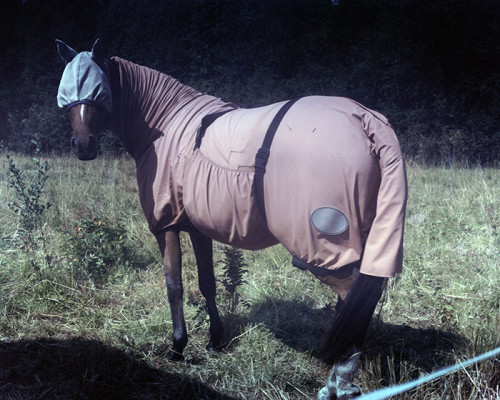
Martina Hoogland-Ivanow, photography.
“To the extent that narcissism serves as a controlling cipher for our era, backed by capital and other state-subventioned tyrannies, including technological addiction, narcissism’s run calls for inquiry, for a real sense of how it instates the negation of all relation, beginning with the Freudian investigation. “
Avital Ronell
Ronell adds that..“We late moderns, left only with the emptying-out of divine spaces, we’re stuck with what is now known as Father in his legacy of failure…”
So clearly, then, this sense of loss, of something that has been called sacred or divine, or sublime, is felt across western cultures today. And of course this is connected to the appearance (or manufacture) of this new ironic. And an aspect of this is connected in turn to what Adorno saw in the way images were being *read* and not observed. That reading was a deciphering of fixed codes, of uniform (or semi uniform) graphic signs, in a process of what Samuel Weber called “an effort to reduce the strange and alien to the known and familiar”. And Weber adds, alluding to Benjamin, that allegory is always *theatrical*. For this reading of codes is partly an aspect of all reading, but that leads into very dense territory, and for the purposes here, the point is that by the time of the industrial revolution, and later of mass electronic media, the processing of these representations — not by observation but by reading — was symptomatic of the traumatic (and hidden or concealed) core of mass culture. For Adorno, ‘the culture industry’. For this reductive process of reading codes and signs, as Weber writes….“marks the limits of the unified individual and, perhaps, the limits of subjectivity itself.”
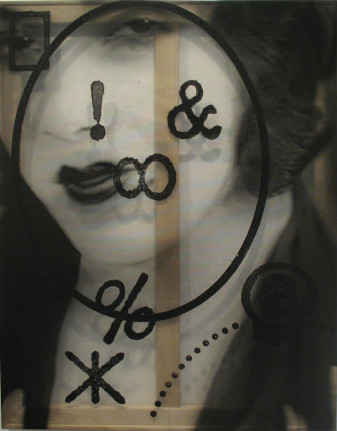
Adriana Lara
There is something essential to all this in the idea of repetition.

Xu Zhen
“The aims of both the unconscious and the ego come together in the compulsion to write.”
Andre Green
Children love to the same story read to them over and over. Freud noted the pleasure of constancy for children. Later, the adult can develop *compulsions* to repeat, and this repetition is one not of memory but of action. The repetitive action. The acting out of repressed material. It is worth noting that Freud also observed that repetition was a quality of animal life; seen in the migratory flight of birds, fish returning to spawn, etc. But the point here is that while children experience pleasure in repetitions, especially of narrative (but not exclusively) the adult has forgotten the traumas that he acts out. In a certain sense this is a performance of forgotten material.
“Narration repeats not only by what it says but also by what it does: performing, enacting that which gets concealed by the telling.”
S. Rimmon-Kenan
The primal scene in Freud happens at night. In all gothic literature the crime is at night, and usually deep within the house (or castle or beneath it, etc) and accompanied by strange sounds. The night hides the source of these sounds (creaking floorboards, wind, etc). Whatever the conventions the uncanny is linked to repetition and repetition to forgotten trauma. The return of the repressed. Now the loss today of narrative that is not entirely anticipated suggests that absence, the space for hiding things, is being eliminated. It is day 24/7 now, and at some point the implications of artificial light should be analysed at length. But the removal of hiding places, literally and metaphorically, is associated with progress. Shadows equated with insanitation and contagion. There are, metaphorically, dams built to prevent the return to spawning grounds.

Uwe Wittwer
At issue is this elimination of interior life. And it has taken several avenues to reach the same destination. One is associated with language, one with ideology and Capitalism and class war, and one is psychoanalytical. And all of them of course are related. Now there is one paragraph in Weber’s book Theatricality as Medium, that I think warrants some questioning. In speaking of Adorno’s early book on Kierkegaard, there is mention of a scene where a man (Kierkegaard) sits by a window staring out at the town square, and at night. Weber says the scene is theatrical, which is true. But then adds…“…the interiority of a theatre is very different from that of a private home or domestic house. In a theatre, on stage, as part of a scene, subjects are no longer authentic, no longer at home, no longer fully in control.”
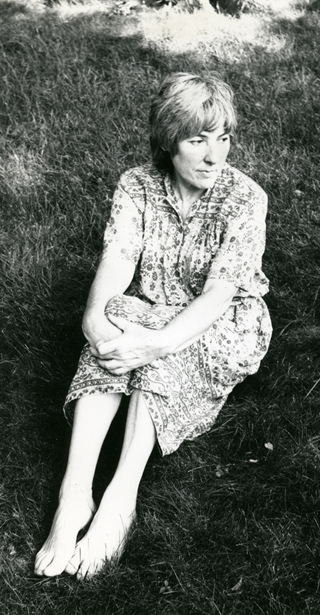
Hannelore Baron
Now, Joyce McDougall and others have explored some of the ideas of psychoanalysis and theatricality, but I think there is a lingering question having to do with, perhaps, language, but also with this idea of identification. The theatre is in my head — metaphorically. It is also out there on stage — metaphorically. Neither is more metaphorical than the other. For every *real* stage is also a metaphor for a stage. This is something Artaud understood instinctively. That passage in Kierkegaard is dream-like. And the sense of dreaming and the uncanny is very important, as is the dreamwork and repetition. Robert Hullot-Kentor noted that Adorno felt every fragment of Kierkegaard could be dissected in extreme detail because each included in itself its opposite as its own essence. And this opposite is the whole.
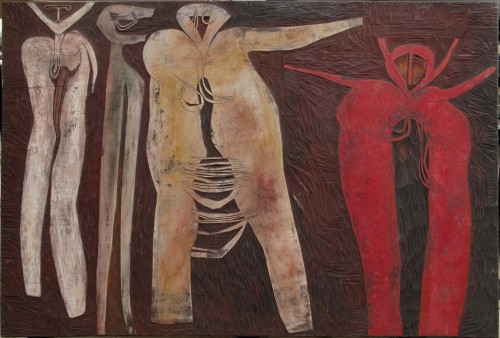
Cecil Skotnes
“Just as in Adorno’s aesthetics, then, the artwork is socially interpretable not because it represents society, but because it acquires social content through resistance to society and is the unconscious writing of history, so Kierkegaard’s inwardness, the spiritual *interieur*, gains its determinations through negation.”
Hullot-Kentor
This is important because, at least for Adorno, this sort of inwardness failed to recognize the class based asceticism that is baked into it. The metaphorical theatre is both real and unreal. The idea of performance is both a real life phenomenon and a ritual (theatre and stage). So, the loss of what Kandinsky and Kuspit refer to as spiritual, is what is subsumed and eradicated by mass culture, a culture almost based on pathological repetition. From muzac in elevators to jingles to TV sit coms and news, to Hollywood comic book summer blockbuster — and to the restrictive tortures of social media, there is a massive economic force at work in distributing artworks that are really just blunt force objects of psychic battery.
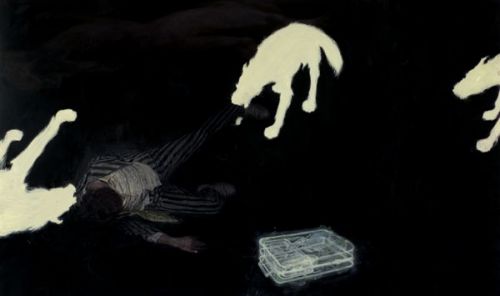
Ruprecht von Kaufmann
There is a gigantic material apparatus of various technologies that operates as some kind of malevolent unseen authority. That the societies of advanced Capital now work in the service of something that less removes interior life as occupies it, that substitutes for the night and shadows that are the scene of the crime, a new non place of coercive suggestion. A flood lit warehouse parking lot under CCTV coverage. Everything is remote and on auto pilot. The smart machines are the new spiritual in a sense. And the acting of repetition is now stolen away from the actor, on stage or not, and given over to computer algorithms.
“Before or simultaneous with the invention of gods, many effigies possessed the powers to protect prehistoric humans from the spirit world and the night.”
Julie Kristeva
The objects of which Kristeva writes were largely meant NOT to be seen by the living. They were buried with the dead, or placed in crypts or simply placed away from sight in ritual locations. They were returned to the invisible, as Kristeva puts it. And this is perhaps the power of Hannelore Baron’s work. These are artworks meant to be given back to the dead. The idea of subjectivity, as Kuspit writes of it, in terms of art, is linked to repetition as it is an acting out of forgotten repressed material, and hence a regression, but also out of sight. Melancholia (and Kristeva writes of this a good deal) comes from a ‘black sun’. Invisible rays that pin one to the earth, to bed, to silence. The mute voice is also a hidden voice. And all of this is today parodied in the kitsch material of Hollywood or the high end galleries of New York and London. The system intuits when to create the ersatz spiritual, and one can see no better example than Marina Abramovic — and while I tire of mentioning her, the fact is, she is the perfect exploiter of a cultural vacuum in need to a radical subjectivity. Of the spiritual. The manufacture of these ersatz offerings affects the obsessional neurosis of the actor. It does not pass without notice and this returns to the topic of Kandinsky and the forms that have reached their fulfillment. But before pursuing that, I want to track something else Kristeva said; that language in some ways comes out of loss, the missing maternal face and sensory contact. And when that maternal is absent or corrupted there is a dream of it. Kristeva calls it a hallucination. Perhaps. She suggests the averted gaze attaches itself to nothing, all faces become the same face. The autistic stops distinguishing in many cases, and avoids language. There are a series of taboos that intersect here, but the point is that our archaic psychic formation incorporates a failure of the psychic economy. And perhaps Kristeva is right to link this with totemic fixations on skulls and to cannibalism. Kristeva writes…“words are food, signs satisfaction”.
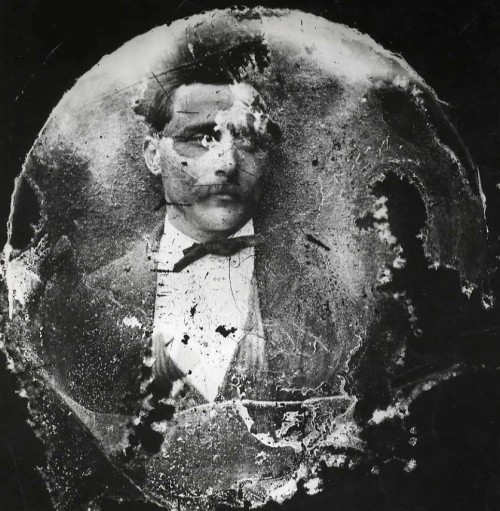
Unknown photographer. Appx. late 19th century. United States.
Kuspit is of course correct that art is more and more ideological, but it also more and more anti-human. The human element, which is an embedded subjectivity, is marginalized. And the public is their own ever more desperate need to counter a sense of absence, feeds more frantically off a constant stream of electronic product. Warhol through Jeff Koons is about everything that is not human. Objects are de-linked from their creation, manufacture, and use. They rarely even connect to exchange value. It is less about surface than about the removal of the world. Warhol gave scant attention to backgrounds. Hollywood and network TV comic book franchises are, for the most part anyway, very much the grandchildren of Warhol in one sense. The original Marvel and DC comics from the 1930s share little resemblance, in sensibility, with Hollywood versions of them today.
There is a hunger, almost an instinct of survival today to reclaim something of a public world. And to restore even some small shred of community. It is hard to imagine artists like Clyfford Still withdrawing his works from the public, or Thomas Bernhard denying his home country the right to perform any of his plays. This was not that long ago, and yet such ideas would be widely ridiculed today.
“Historically the self became powerful by developing the ability to mediate in itself its relation to the world. By confronting the world the self became a microcosm of the tensions of the whole on which the self could then reflect and conceivably find resources within itself for asserting its own necessity.”
Robert Hullot-Kentor
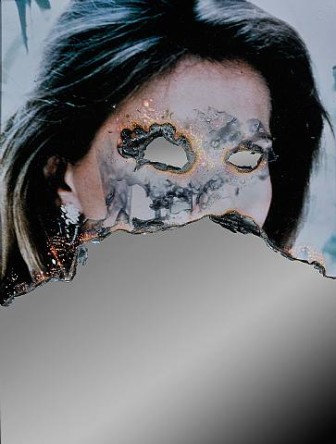
Douglas Gordon
The new non subjective citizen forms opinions based on self image. Content is free floating style. Hullot-Kentor observed that the very wealthy today, financialized and in control of fortunes unheard in modern times, continue to accumulate money through mechanisms that circumvent the self. And today, most people have no relationship to the whole and in fact mostly can’t form any idea of what that means. And this is also something that is harder and harder for everyone because of the erosion of meaning in language. And in turn the strip mined psyche of the West, in its role as a public person, rests on identifications with media images and story. So, the observations of Kuspit, Weber, and Kristeva, and the itemizing of what is missing, is important for any idea of reclamation. Hullot-Kentor in an interview in 2011, said…“What strikes us as distressingly obsolete is invariably a blocked longing.” And that is not a simple idea at all. For the missing qualities of sacredness, of the divine, or the spiritual, is, at its most basic level, just the capacity to think, silently, meditatively, about being alive.
Paul Riceour has said that memory is replaces repetition and resistance. Remembering. What Freud called *working through* (interesting spatial image) has as its aim the recovery of memory. So in one sense, the recovery of something like public life, a public world, is linked to memory.
“But what is it to remember? It is not just to recall certain isolated events, but to become capable of forming meaningful sequences and ordered connections.”
Paul Ricoeur
In other words to constitute one’s own history as a narrative. And this is at the heart of so many things only tangentially related. And this becomes increasingly complex for the positivist logic of many today. For the work of excavation is not ordered in a linear manner. Experiences and impressions, as Lacan made clear, can be revised. They are fitted to new experiences, interpreted anew. This is a part of how magic came to be. There is no linear determinism. Our dream life is timeless, remember (sic).

Marcelo lo Giudice
Our memory, and this is true even more with repressed material, is not some camera in our head that records the past and which can they be made to replay what was recorded. It is a complex system of structural adjustments, modifications, and questioning. And it is in this *working through* process that new structural forms are invented. And this is partly where art and magic occur. Today, Id wager almost all of the population of the West thinks in mechanical terms about sensory matters and about memory. This is another aspect of the reductive template forced on experience. And it helps constrict experience so that what is anticipated as acceptable is recorded and what is anticipated as problematic (anything undefinable or mysterious) is rejected and left out. I often wonder if the traumas that are repressed are, increasingly today, not bleached and cleansed of their deeper energetic charge. Like a mental surge bar in the psychic economy. And this would also suggest this generalized autism (Debord) is more and more often the tactical mental action. Our traumatic stock portfolio is also being diversified in that sense. Risk management.

Clyfford Still & daughters.
One of Ricoeur’s observations is sort of self evident, but worth noting, and that is that psychoanalysis, in theory, is similar to textual interpretation. The disciplines of textual examination are really being applied to what are relations of energy and force. And Freud was aware of the implications of this. I mention this aspect because it is another, though milder, version of conceptual cataloguing. However, it also demonstrates how human society and community are intertwined if not predicated upon, stories and ritual. And I mean ritual in terms of cultural expression. Our history is made up of folk tales, myths, music and dance traditions, and in fact the idea of tradition is based on remembering. So, a hermeneutics of memory is only different from philology or other disciplines by virtue of treatment. Or what is discovered in treatment. And this is again, where mimesis enters the discussion. Psychoanalysis is bodily. The mimetic engagement is *felt* as well as thought. Today, I suspect less is felt. It is blocked longing, dammed rivers of instinct, and instead a tripling of repetition. A repetition that is reflexive and even spasmodic.
I think it was Norman O. Brown who said anxiety was the ego’s refusal to accept death. The need for unity in the self is expressed in society by bureaucratization. The romantic tradition, if we want to call it that, from Chamfort and Pascal and Montaigne even, is one that accepts lack of organization in an effort to de-sublimate. Today, the world of computer code and screen life is one that constantly asserts an image or idea of system but which is largely illusory. It is the image of unity, but it is not unity. For there can be no unity. There can only be re-unification. The contemporary form of rationality is in fact highly irrational. And the proof of that is the calamitous state of the planet. In film school twilight is referred to as a ‘magic time’, and optimal for filming. Half of Chinatown is filmed at twilight. And this is partly just the sense we have, intuitively, of a border region between light and dark. They hyper illumination of contemporary society is a refusal to accept the dark. It is another denial of death. Twilight is always melancholy. N.O. Brown wrote that the ego must “always mediate between external reality and the Id.” And one role of culture is to express this mediation, in a sense. So again, the fragment is a negation of a principle of unity. It is a kind of submission to an inherent disorder. And artworks of any value are always existing in border regions. And such mediation is less and less allowed in modern pedagogy for the arts. But it is never just denial, it is always the substitution of false mediation for real mediation. This is, I think, a perfect definition of kitsch. It is a replacement for that which is too terrifying to contemplate.

K. H. Hodicke
With the advent of Pop, and led by Warhol, the replacement vehicle was found and embraced. The art market is highly ambivalent in its tastes. One part of what drives the market is rich collectors wanting to find what will make the biggest splash — the biggest *noise*. So anything spectacular in its presentation is likely to sell high. But there is also a desire for the spiritual, a desire to steal the fire of the Gods. Rothko sells for insanely high prices and his tragic end is certainly a part, but it is a desire to appropriate the sincerity of this work, the spiritual, the authenticity. If I can put a Rothko or Still or Newman in the lobby of bank’s headquarters, then I am killing it in a way. It is trophy hunting. No surprise that the royal family still hunts, that Trump’s two idiot sons hunt. Of course they do. Buy the right, the privilege to kill. That’s an interesting topic, actually, because Trump junior(s) would never work the killing floor at the local abattoir. You wont find them in plastic gloves and paper mask chucking little baby chicks into a meat grinder. Prince Harry isnt found standing around with a captive bolt pistol and executing cow after cow all afternoon. No, for rituals always supercede the deed. For those elite trophy hunters are really killing the underclass. That’s the symbolism. Not just any killing will do. If they could they would organize fox hunts to chase down the poor. But I digress. The rise of Pop coincided with the rise of a new more powerful and influential art market. A corporatized museum culture, and a new barker persona for major gallery owners. And of course institutions fell in line with this.
Over at the Lana Tuner blog…
“Contemporary American warfare in the pockmarked landscapes of distant earth no longer succeeds in horrifying us. No atrocity in Iraq or Afghanistan seems capable of sending a ripple of feeling – let alone effective rage – across our cyborg body politic. (Or, if so, impotence ensues leading to the dissipation and dispersal of this intensity – its slow and seemingly inevitable release into our free-floating and impersonal ephemerality.) This vast mutation in the American life-world that occurred roughly between the My Lai Massacre (1969) and Abu Gharaib (2004) required the antennae of sci-fi mutants such as Philip K. Dick and culture barometers like Fredric Jameson to be detected and recorded: the earlier epoch’s signs of mental illness or “absence of appropriate affect” are now vague survival mechanisms of flattened feelings. The war just goes on pummeling someone somewhere beyond any distance, unless you are the hapless relative of a soldier who went on a murderous rampage “out there,” or of one who has committed suicide since returning, or of one left to suffer and die in privatized neglect at Walter Reed Army Medical Center. Nothing of the collective suffering that accompanied such hurt in our previous, penultimate moment seems to inform any effective politics regarding those on the home front, let alone our victims on the other side, worlds away.”

Cristofano Allori (1613).
Freud said protection against stimuli was probably more important than reception of stimuli. We exist in spatial metaphors; inside and outside, above and below, and with sensory symbols such as night and day. And Western thinking, since Kant anyway, has had a default setting of inside and outside (except perhaps Wittgenstein). But increasingly even such basic metaphors are dissolving. The post modern has been a project of erasure as much as anything else. And kitsch opposition. Its probably wrong to blame French post structuralists, because most of them have had their kitsch replacements, too. But this has little import unless one recognizes the loss, the elimination, really, of allegory. And this means of an allegory that is connected to history and memory. For without that, the contemporary consciousness of much of the West today is one (as described above) of flattened feelings — loss of affect. And with ever less community and traditions of knowledge passed on, the substitution of cheap replacements is normalized to the degree that the most recent generations are not even aware a loss has taken place. When Norman O. Brown said that even without the dream censor {psychoanalysis} we would still have symbolism, he was pointing toward something archaic in consciousness. Accept this or not, the mystical imagination (David Greenham’s term) is tied to a desire, a sense of searching for those unresolved details. For the scene of the crime, though suspecting that you yourself *are* the scene, are at least the performer. The film Angel Heart (1987, Alan Parker, dr.)- (somewhat neglected)- is pretty much that story. The Devil sends you out to search for yourself and your crime. Hires you, actually. And you suspected all along.
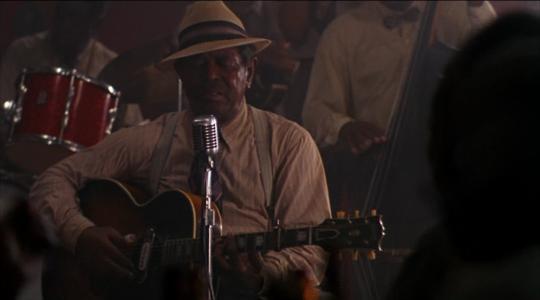
Angel Heart (Alan Parker, dr. 1987). Brownie McGhee’s great cameo.
“The paramount relation between poetry and painting today, between modern man and modern art, is simply this: that in an age in which disbelief is so profoundly prevalent or, if not disbelief, indifference to questions of belief, poetry and painting, and the arts in general, are, in their measure, a compensation for what has been lost.”
Wallace Stevens
The so called age of madness, the middle 15th century to the end of the 16th in Europe, is worth examining in light of contemporary social trauma. Foucault said of the Renaissance…“madness and madmen became major figures, in their ambiguity…” The time of Bosch and Brueghel, of Cervantes and Shakespeare. The Dionysian energy of late antiquity lived on festivals and feasts. But the ambiguity is found in the exaggerated interest in the monstrous. In deformities and disease and all things that signaled sin, symbolized something dark and unnatural. This is a hugely rich topic, but the trend was subsumed, at least partly, with Luther and the reformation. Luther wrote and sermonized often about monsters. Camerarious in the late 1500s wrote of the forebodings in nature, eclipses, and “terrifying events of unknown causes”. He wrote of flaming swords and comets and ‘hideous monsters’. There is abundant literature on God’s judgment on man in the form of misshapen babies and unnatural nightly sounds. The ruling class sought to punish the poor, blaming them, for the most part, for their wickedness. Jean Delumeau wrote that the if a title were needed for the 14th to through 16th centuries it might be All Goes From Bad to Worse. The Church, the plague, and rising violence. The birth of the macabre. And culminating, perhaps, in the witch burnings of the 17th century. Norman O. Brown’s analysis of Luther is certainly relevant here, for we live in the shadows but do not see.
“Luther’s devil is a negation of the classical sublimation, sublimation is repudiated because the body is perceived as fallen and filthy; the devil regains, by a return of the repressed, his excremental character, but his anality is not cathected with libido or magic life, as in the magic dirt complex, but is seen as death. The whole evolution from Trickster to devil and on into the pseudo securlar demonic of capitalism show the progressive triumph of the death instinct.”

Hi Steppling,
This post (and your previous one) reminded me of something that happened recently at my university where I am both a custodian and an first year PhD English student. It has to do with a project that I did on my office door (a shared office door – shared with 4 other grad students, whom I did not consult about the “project”).
Last fall, I covered the office door completely with hundreds of tiny pictures from old children’s picture dictionaries and textbooks. The door became very popular. People liked it. It was intricate and detailed and interesting to look at.
This winter term has been exhausting. I left the city to stay at my empty parent’s house (they were on vacation) to get away from the noise of the city and the institution. I stayed alone, and for some unfathomable reason, I started thinking about the colour red. It kept coming into my mind – images, phrases, associations with ‘red.’ I wrote them down. I made a list. I didn’t know why but it felt like that’s what needed to be done. It felt like the writing and the images were speaking something that I couldn’t process in all the “healthy” or “normal” or “conventional” ways that one is “supposed” to do to process or live with uncertain or difficult things (take your pick, there’s millions).
When I returned to school after 5 days alone, I stayed at the university late one night and painted all of the tiny pictures on my office door red. Then I took my “list” that I generated – which is really more like a “narrative list” than a “list” (though others call it a “poem”) – and I painted the pages of the “narrative list” in a wash of red, and hung it to the door as a sort of cipher for the painted pictures; the text and pictures illustrated and worked for each other.
When I returned to school the next afternoon, I was notified that my “artwork” had caused a scandal. I was incredulous. I asked my informant why and they said, “because you painted the pictures red. People have associations with the colour red.” This was hilarious! Clearly the people upset had not read the text. Anyone reading the text would be able to see that the “artwork” was grappling with exactly that question: “What does ‘Red’ Signify?” There were apparently threats to report me to “the administration” (whatever that means).
The other reaction was that I was “having a nervous breakdown” or that “something was wrong” with me. This was again surprising and a little infuriating. I am not interested in people using me as an entity against which they affirm their own normalcy. I am also irritated with the assumption that there is something “wrong” with me. I appreciate that the “artwork” (as some people called it) – certainly hints at “dark” things, and is not about rainbows and sunshine (though it does have its playful bits), but all the same, human beings don’t have to be happy and complacent all the time – and in fact, we shouldn’t be, because the world is suffering! Besides, even if I was having a “nervous breakdown” (whatever that means), what’s wrong with that? Wake up people: the world’s a dangerous place.
A student told me that he really liked the “artwork,” but that maybe the problem was that it was put up in a “public work space” where people couldn’t “choose to get away from it.” What!? Does “artwork” or “expression” only belong in the art gallery? Is it okay to say to oneself, “i feel like seeing something different and subversive or ‘edgy,’ i think i’ll go to the art gallery where I can step in there and expose myself to whatever is being expressed and then i can just leave it behind, tucked away in there where it belongs and get back to my fucking normal life”? I mean COME ON PEOPLE! I do not watch television or movies very often. I know that my peers are watching violent crime dramas with stories of rape, murder, hate crimes, shootings, blood – and most of these TV shows are narrated through neo liberal assumptions. But when violence isn’t contained safely on HBO or the news during the time and place when I ‘choose’ to see it, then it just isn’t acceptable, and is an attack on my comfort. Well, that very idea that we can “choose” to see manufactured violence and ignore violence at will IS A VIOLENT ASSUMPTION, a negation of responsibility, and a narrow sense of reality! And sure, because it was a visceral, affective project, people may have felt uncomfortable with that, especially from a person they kind of know, or at least see around the hallways. Apparently, it makes some people uncomfortable to “speak” in any other way than empirically based, institutionally acceptable ‘critical’ rhetoric.
I ended up taking down the stuff on the door and putting it in a clear, plastic garbage bag (which looks more than ever like a bag full of spliced body parts). I took it down for a number of reasons and I now actually regret doing so and am ashamed for my cowardice in taking it down. Several people did tell me they found the door very provocative (in a welcome way), and I really only took it down because of a rumor and never gave any dissenters a chance to directly confront me or threaten me with “the administration.” By taking it down, in some respects, I was basically conceding that the dissenters were “right” and that I had done something “wrong,” which I genuinely don’t believe I did (and if I did do something “wrong” or “hateful”, it remains unclear as to what that was). All the same, I am going to be here for a while and this “project” was just an exploration, an offering, a reaching, a questioning, a grappling with something that I don’t understand – but it wasn’t a big enough deal for me to cause a scandal, and although i don’t mind troubling people (and myself), i really don’t mean to hurt people. I’ve got to try and make sure that the “artwork” is doing its “work” and that it doesn’t get completely appropriated for some neo-liberal, violent means that i wasn’t aware of at the time of making it. Besides, I can’t entirely spoil my reputation (however tenuous it might already be) quite yet…
Another note, on crime. I just wrote the thing as it came and didn’t try to craft it in any particular way; it was sort of “speaking through me” – if I can put it that way. But after putting it up and then causing the stir (however minor it might have ended up being), I felt like a criminal. I felt like I had killed someone (possibly myself), and stuck the remains on my office door and that I had to go through the public shaming of being condemned to public service (taking it down), and possible indictment for being criminally insane. After taking the thing down, I kept re-reading the text to figure out what it said… what was going on… what people might have thought had they read the whole thing… and I realized that the text is about a crime. So oddly, in a further deranging sort of way, I sort of became the “artwork.” I was ‘artist as criminal’ and ‘criminal as artist.’ I felt I had become the protagonist in the “list narrative,” not just the conduit or ‘writer’ of it. And by “publishing” the story in such an intimate work space where it was most “readable” by a minority of people who had seen the pictures on the door for months before they were painted – perhaps my ‘crime’ felt more personal – against them and myself. But that’s just part of the problem: the “personal” and “subjectivity” are being replaced by the “individual” and the “mass.”
Anyway, I’ve learned my lesson (now living with the shame of taking it down). Next time people are troubled, I’ve got to let the work speak for itself and take the risk. I was going to be harassed either way: leave it up, get flake from needy people; take it down, deal with the isolation of my own shame…
@calla…fantastic comment. I say that because you really do capture the sense of why art matters and the potential seriousness of creating. Just the act of creation, if it is invested with something sincere, some search, the results can be very disruptive for many people.
The other thing this reminds me of is that today the term *artist* is so debased, so touched with contempt and irony, that people have to think of it as a sort of occupation, a gig, and that you put in some time and crank out some junk etc. I remember the first time i had a play done….long time ago, and I felt as if i had been put in the stocks and whipped in public.
And….this raises another question that I had wanted to get at in this post. Some people are artists, are creative, are sensitive to that *thing*….and some arnt, Most arent. Some very very very very very very smart people I know have tried to write plays or stories and they failed, badly., And I was thinking today, that the difference between artists and non artists is the ability to invest yourself in the work. To really do that and not pretend to do it. And of course that is not easy and Im being horribly simplistic, but that sense of self laceration that comes from writing, from creative writing, costs the writer. And it often makes artists crazy,. And they are always selfish. They can be kind and even generous in some ways, but their overriding sensibility is selfishness. And its exhausting. And some smart people just have this distance from their voice. Mednick use to say, listen….he;s very gurdjieffian…..listen and keep listening to what is inside you. Find that voice, that sound, that is there beneath all the chatter and noise and media and crowds. And when you hear that, then you can write. But today for many, that voice has gone even deeper into hiding.